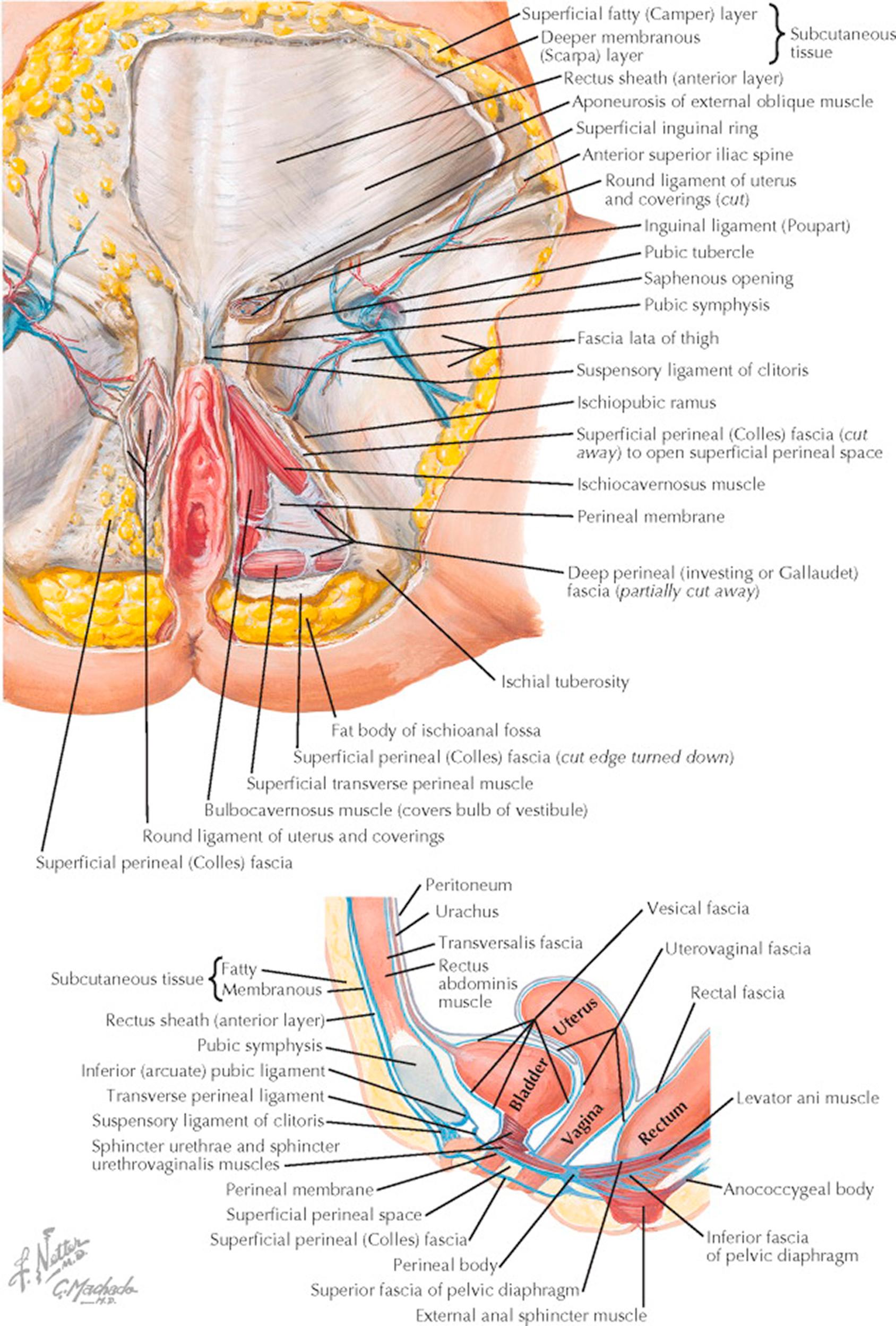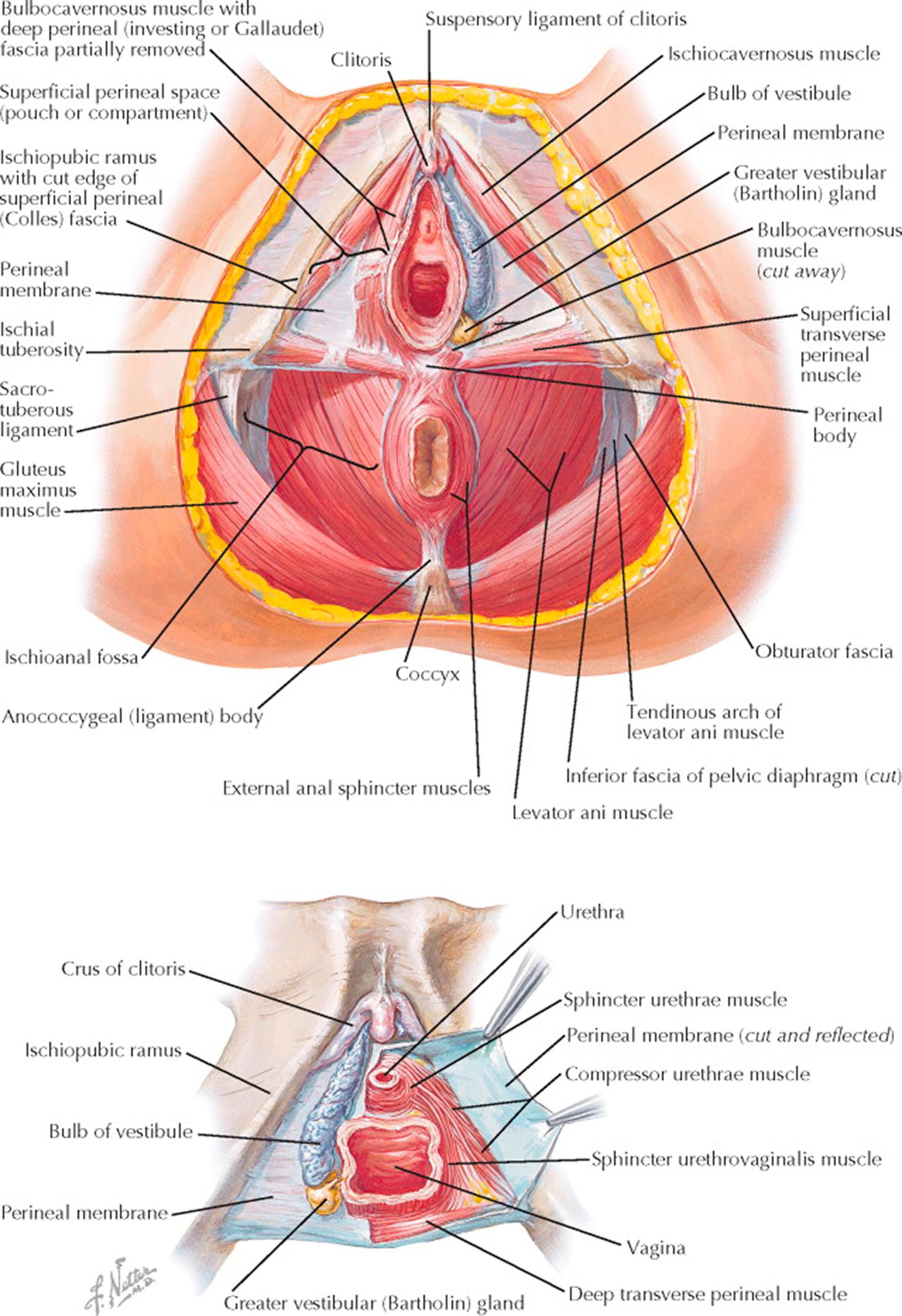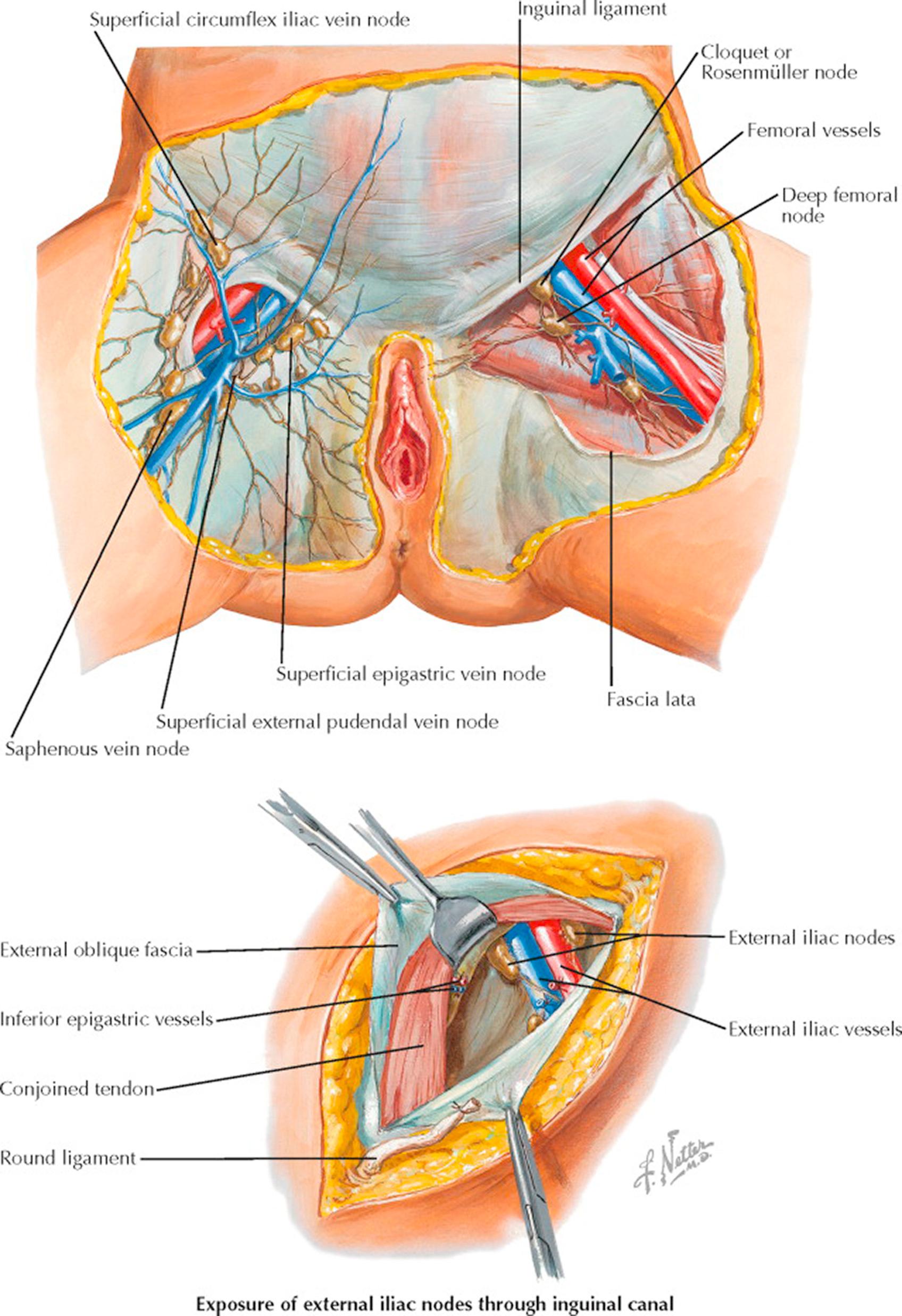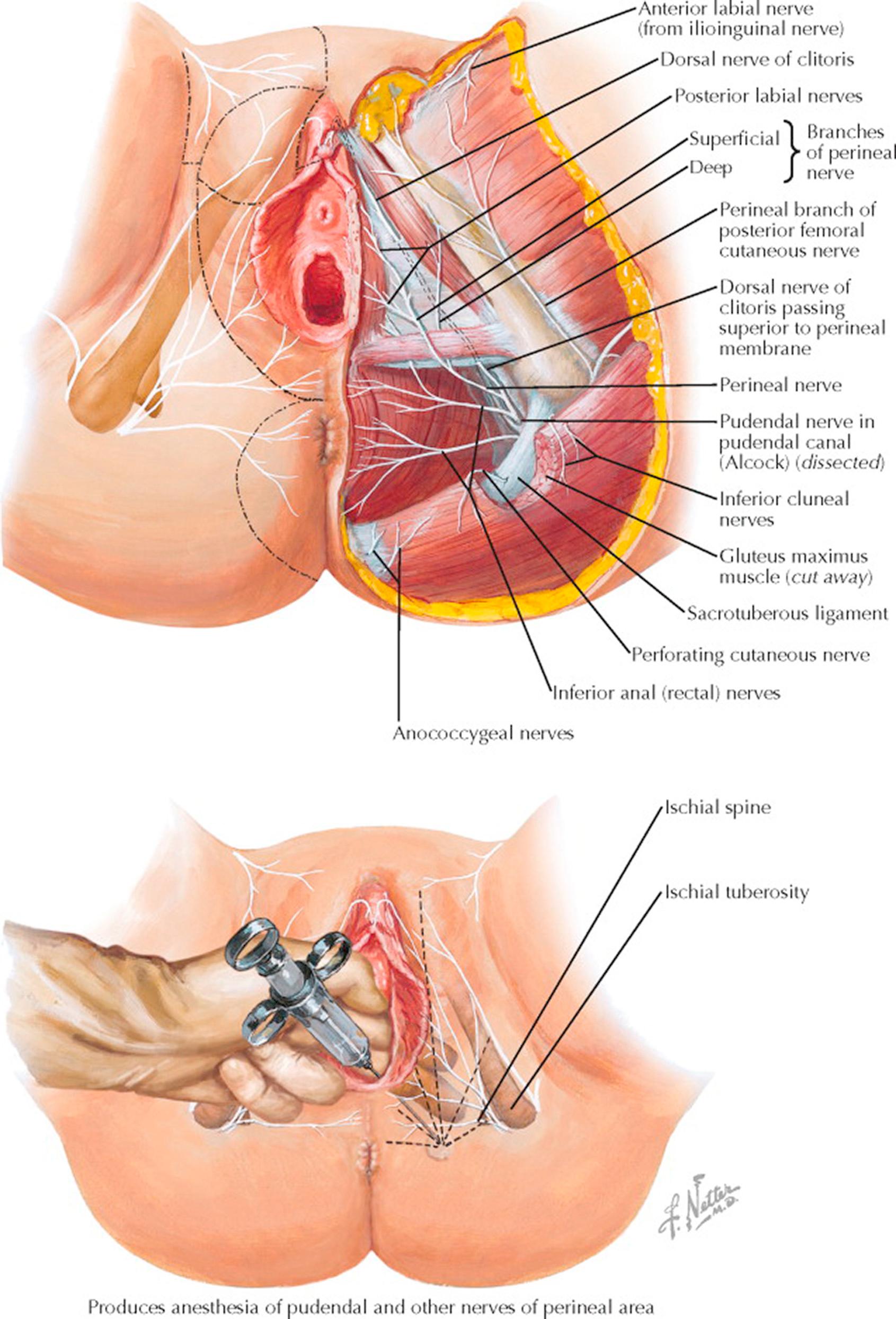Physical Address
304 North Cardinal St.
Dorchester Center, MA 02124
The vulva includes those portions of the female genital tract that are externally visible in the perineal region. The mons veneris, overlying the symphysis pubis, is a fatty prominence, covered by terminal sexual (pubic) hair that functions as a dry lubricant during intercourse. From the mons, two longitudinal folds of skin, the labia majora, extend in elliptical fashion to enclose the vulval cleft. They contain an abundance of adipose tissue, sebaceous glands, and sweat glands and are covered by hair on their upper outer surfaces. The anterior commissure marks their point of union at the mons. Posteriorly, a slightly raised connecting ridge, the posterior commissure or fourchette, joins them. Between the fourchette and the vaginal orifice, a shallow, boat-shaped depression, the fossa navicularis, is evident. The labia minora are thin, firm, pigmented, redundant folds of skin, which anteriorly split to enclose the clitoris; laterally, they bound the vestibule and diminish gradually as they extend posteriorly. The skin of the labia minora is devoid of hair follicles, poor in sweat glands, and rich in sebaceous glands. The skin of the labium majus, and to a less extent the labium minus, is subject to most of the same dermatologic pathologies as other areas of skin.
The clitoris, a small, cylindrical, erectile organ situated at the lower border of the symphysis is composed of two crura, a body, and a glans. The crura lie deeply, in close apposition to the periosteum of the ischiopubic rami. They join to form the body of the clitoris, which extends downward beneath a loose prepuce to be capped by the acorn-shaped glans. Only the glans of the clitoris is generally visible externally between the two folds formed by the bifurcation of the labia minora. When the clitoris is abnormally enlarged as a result of exposure to excess androgens, the clitoral index (the product of the sagittal and transverse diameters of the glans, in millimeters; normal <35 mm 2 ) is used to grade the degree of enlargement.
The vestibule becomes apparent on separation of the labia. Within it are found the hymen, the vaginal orifice, the urethral meatus, and the opening of Skene and Bartholin ducts. The external urethral meatus is situated upon a slight papilla-like elevation, 2 cm below the clitoris. In the posterolateral aspect of the urinary orifice, the openings of Skene ducts lie. They run below and parallel to the urethra for a distance of 1 to 1.5 cm. Bartholin ducts are visible on each side of the vestibule, in the groove between the hymen and the labia minora, at about the junction of the middle and posterior thirds of the lateral boundary of the vaginal orifice. Each duct, approximately 1.5 cm in length, passes inward and laterally to the deeply situated vulvovaginal glands. The Bartholin glands are situated posterior to the 3- and 9-o'clock locations, which is important clinically when a Bartholin gland abscess is considered in patients with labial swelling.
The hymen is a thin, vascularized membrane that separates the vagina from the vestibule. It is covered on both sides by stratified squamous epithelium. As a rule, it shows great variations in thickness and in the size and shape of the hymenal openings (e.g., annular, septate, cribriform, crescentic, fimbriate). After tampon usage, coitus, and childbirth, the shrunken remnants of the hymen are known as carunculae hymenales or hymenal caruncles. The presence or absence of an intact hymen is insufficient to determine the presence or absence of past sexual activity.

The superficial fascia of the anterior abdominal wall has been cut away, exposing the aponeurosis of the external oblique muscle, with the linea alba in the midline and the linea semilunaris laterally outlining the rectus compartment beneath. Below are the inguinal ligaments, continuous with the fascia lata of the thighs, and the structures of the perineum superficial to the inferior fascia of the urogenital diaphragm. The fascial layers of the canal of Nuck emerge from the superficial inguinal ring and descend toward the lateral margin of the labium majus. These layers are composed of fibers both from the aponeurosis of the external oblique and from the transversalis fascia. The innermost layer is closely applied to the round ligament, which becomes more attenuated as it descends and eventually terminates by fine, fingerlike attachments in the labium majus. Within this sac is a vestigial remnant of peritoneum, the homologue of the tunica vaginalis in the male. The canal of Nuck may persist in the child or the adult in a patent form and may then give rise to inguinal hernias or the so-called hydrocele feminae. Adjacent to the terminal portion of this process on the right side is Colles fascia, attached laterally to the ischiopubic ramus and inferiorly to the fasciae, covering the superficial transverse perineal muscle, which forms the upper margin of the ischiorectal fossa.
Lateral to the subcutaneous inguinal ring and below the inguinal ligament lies the fossa ovalis surrounding the femoral artery and vein. Close to the fossa are the origins of the inferior epigastric, iliac circumflex, and superficial external pudendal vessels.
To expose the superficial muscles and inferior fascia of the urogenital diaphragm or triangular ligament, Colles fascia has been cut away on the left side. Closely applied to the left lateral wall of the vagina and lying below the labium majus is the bulbocavernosus muscle, which passes from the central tendinous point of the perineum to be attached in the corpus cavernosum and suspensory ligament of the clitoris. This muscle also is a constrictor of the introitus. At right angles to the bulbocavernosus muscle and similarly attached to the central tendinous point is the superficial transverse perineal muscle, which runs laterally to the tuberosity of the ischium and helps support the midportion of the pelvic floor. The ischiocavernosus muscle is the hypotenuse of the triangle formed by the bulbocavernosus and the superficial transverse perineal muscles and runs from the tuberosity of the ischium upward to be inserted in the crus of the clitoris, which it covers for most of its length. Within the triangle is the inferior fascia of the urogenital diaphragm, which blends with the deep fibers of Colles fascia. The triangular shape of the whole urogenital diaphragm stands out clearly in this view, with the apex at the symphysis pubis, the ischiopubic rami forming the sides, and the transverse perineal muscles connected by the central tendinous point of the perineum, the base. The external anal sphincter sends interdigitating fibers to join those of the transverse perineal, bulbocavernosus, and pubococcygeus muscles in the central perineum.
The lateral view illustrates the manner in which the muscles and fasciae of the urogenital diaphragm are applied to and support the pelvic viscera. The urogenital fascia is composed of a superior and an inferior layer joining to form a single ligament anterior to the urethra and posterior to the vagina. Elements from these cover the outer surfaces of the pelvic viscera, where they are known as the endopelvic fascia. Composed of smooth muscle as well as fibrous tissue, they are thin superiorly where they lie just beneath the reflections of the pelvic peritoneum, but they become thicker as they approach their attachments to the upper fasciae of the urogenital diaphragm and levator ani muscles.

The mons veneris in front, the buttocks behind, and the thighs laterally bound the perineum. More deeply, it is limited by the margins of the pelvic outlet, namely, the pubic symphysis and arcuate ligament, ischiopubic rami, ischial tuberosities, sacrotuberous ligaments, sacrum, and coccyx. A transverse line joining the ischial tuberosities divides the perineum into an anterior urogenital and a posterior anal triangle.
The perineal floor is composed of skin and two layers of superficial fasciae—a superficial fatty stratum and a deeper membranous one. The former is continuous anteriorly with the superficial fatty layer of the abdomen (Camper fascia) and posteriorly with the ischiorectal fat. The deeper, membranous layer of the superficial perineal fascia (Colles fascia) is limited to the anterior half of the perineum. Laterally, it is attached to the ischiopubic rami; posteriorly, it blends with the base of the urogenital diaphragm; and anteriorly, it is continuous with the deep layer of the superficial abdominal fascia (Scarpa fascia).
The urogenital diaphragm is a strong, musculomembranous partition stretched across the anterior half of the pelvic outlet between the ischiopubic rami. It is composed of superior and inferior fascial layers between which are located the deep perineal muscles, the sphincter of the membranous urethra, and the pudendal vessels and nerves. It is pierced by the urethra and vagina.
The anal triangle is delineated by the superficial perineal muscles anteriorly, the sacrotuberous ligaments and margins of the gluteus maximus laterally, and the coccyx posteriorly. It contains the anal canal and its sphincters, the anococcygeal body, and the ischiorectal fossae.
The ischiorectal fossae are prismatic in shape. The lateral wall of each is formed by the obturator internus fascia, and its medial wall by the fascia overlying the levator ani, the coccygeus, and the external anal sphincter muscles. The tendinous arch marks its apex. Anteriorly, the fossa extends between the urogenital and pelvic diaphragms. Posteriorly, the sacrotuberous ligament and gluteus maximus muscle limits it. The contents of the ischiorectal fossa include an abundance of fat, the inferior hemorrhoidal vessels and nerves, and the internal pudendal vessels and nerves within Alcock canal.
The muscles of the perineum include the bulbocavernosus, the ischiocavernosus, the superficial and deep transverse perineal muscles, the sphincter of the membranous urethra, and the external anal sphincter. These muscles, in general, correspond to their homologues in the male. The ischiocavernosus muscles are smaller than in the male. They overlie and insert into the crura of the clitoris instead of into the crura of the penis, as in the male. The bulbocavernosus muscles surround the orifice of the vagina and cover the vestibular bulbs. They are attached posteriorly to the central tendinous point of the perineum and to the inferior fascia of the urogenital diaphragm and insert anteriorly into the corpora cavernosa clitoris. They are sometimes termed the sphincter vaginae . Spasms in this muscle group are often found in patients with vaginismus. The pair of deep transverse perineal muscles (within the urogenital diaphragm) is interrupted near the midline by the vagina, into which they insert.
The central point of the perineum lies at the base of the urogenital diaphragm between the vaginal and anal orifices. It is a common fibrous point of attachment for the bulbocavernosus, the superficial and deep transverse perineal, the levator ani, and the external anal sphincter muscles. This area is often referred to as the perineal body.
The anococcygeal body is of fibromuscular consistency and extends from the anus to the coccyx. It receives fibers from the external anal sphincter and the levator ani muscles and serves as a support for the anal canal.

A network of lymphatic anastomoses drains the external genitalia, the lower third of the vagina, and the perineum. Bilateral or crossed extension and drainage is common. The superficial femoral nodes are reached through the superficial external pudendal lymphatic vessels, although the superficial external epigastrics may also play a role. From the region of the clitoris, deeper lymphatic vessels may pass direct to the deep femoral nodes, particularly to Cloquet node in the femoral canal, or through the inguinal canal to the external iliac nodes. Cloquet node is thought to be the sentinel node between the superficial and deep inguinal/obturator lymph nodes. Sometimes, intercalated nodes may be encountered in the prepubic area or at the external inguinal ring. The lowermost portion of the vagina, like the vulva, may drain to the femoral nodes. This complex network of lymph nodes is clinically important, for these are the nodes to which cutaneous and vulvovaginal gland malignancies may drain. Regional lymph node dissections are routinely performed in the surgical treatment of vulvar cancer as the status of regional lymph nodes is essential for therapeutic planning and overall prognosis. Superficial nodes in the groin may also become enlarged when significant inflammation is present in vulvar structures (e.g., Bartholin gland infections).
The inguinal lymph nodes, both superficial and deep, lie within the subcutaneous tissue roughly overlying the femoral triangle (“femoral” lymph nodes). Lymphatic vessels tend to follow the course of veins draining a particular region. The lymph nodes are arranged in groups or chains in close relation to the vessels. The nodes found in this region are generally further referred to as the superficial and deep inguinal lymph nodes.
The superficial femoral nodes are a group of nodes found in the loose, fatty connective tissue of the femoral triangle between the superficial and deep fascial layers. These nodes receive lymphatic drainage from the external genitalia of the vulvar region, the gluteal region, and the entire leg, including the foot: The saphenous nodes drain the lower extremities, whereas the superficial circumflex nodes drain the posterolateral aspect of the thighs and buttocks.
Afferent vessels from the lower abdominal wall and the upper superficial aspects of the genitalia extend to the superficial epigastric nodes in the abdominal wall above the symphysis. The superficial external pudendal nodes drain the external genitalia, the lower third of the vagina, the perineum, and the perianal region. Efferent lymphatic vessels from all the superficial femoral nodes drain to the more proximal superficial inguinal (femoral) nodes, the deep inguinal (femoral) nodes, and the external iliac nodes. Efferent lymphatics from this group of nodes penetrate the fascia lata to enter the deep femoral nodes and represent the greatest concentration of lymph nodes in the female.
A few constant nodes are usually associated with the deeper lymphatic trunks along the femoral vessels. These may be situated on the mesial aspect of the femoral vein, above and below its junction with the saphenous vein. The highest of the deep femoral nodes lies within the opening of the femoral canal (Cloquet or Rosenmüller node). The deep femoral nodes receive afferent lymphatics directly or indirectly from the parts drained by the superficial femoral lymphatics and send efferent vessels to nodes higher in the chain and to the external iliac nodes.
Knowledge of the lymphatic drainage of the perineum can be helpful in the assessment and treatment of patients with vulvar cancers, where lymphatic mapping and sentinel lymph node biopsy may be applied. The sentinel node(s) are those nodes that directly drain the primary tumor and are thought to predict the metastatic status of the upper nodes in the groin.

The perineum and vulva are richly supplied with blood vessels, which become clinically significant during childbirth and surgical procedures. Blunt trauma to the area, such as straddle injuries in children, can result in significant bleeding or hematoma formation when vessels are ruptured and bleeding into the loose compartments of the perineum occurs.
The internal pudendal artery in the female is a far smaller vessel than it is in the male, though its course is generally the same in both sexes. When leaving the lesser pelvis through the lower part of the greater sciatic foramen, it enters the ischiorectal fossa through the lesser sciatic foramen. Here, accompanied by its venae comites and the pudendal nerve, it lies in a fibrous canal (Alcock canal) formed by the fascia covering the obturator internus muscle. The branches of the internal pudendal artery include small ones to the gluteal region, the inferior hemorrhoidal artery, the perineal artery, and the artery of the clitoris. The pudendal artery (and vein) is closely associated with the pudendal nerve as it passes the ischial spine near the insertion of the sacrospinous ligament (on the dorsal aspect of the coccygeal muscle), placing it at risk when sacrospinous colpopexy is performed. (A rare complication of this operation is massive hemorrhage from the inferior gluteal or pudendal arteries.)
The inferior hemorrhoidal artery pierces the wall of Alcock canal and passes medially through the ischiorectal fat to supply the anal canal, anus, and perineal area. The perineal artery pierces the base of the urogenital diaphragm to enter the superficial perineal compartment, where it supplies the ischiocavernosus, bulbocavernosus, and transverse perineal muscles. A constant transverse perineal branch runs along the superficial transverse perineal muscle to the central point of the perineum. The terminal branches of the perineal artery, the posterior labial arteries, pierce the deep layer of the superficial perineal fascia (Colles fascia) to the labia.
The artery of the clitoris enters the deep compartment of the urogenital diaphragm and runs along the inferior ramus of the pubis in the substance of the deep transverse perineal muscle and the sphincter of the membranous urethra, ending in four branches, which supply chiefly the erectile tissue of the superficial perineal compartment. The artery of the bulb passes through the inferior fascia of the urogenital diaphragm to supply the cavernous tissue of the vestibular bulb and the Bartholin gland. The urethral artery runs medialward toward the urethra and anastomoses with branches from the artery of the bulb. The deep artery of the clitoris pierces the fascial floor of the deep compartment just medial to the corpus cavernosum of the clitoris, which it enters. The dorsal artery of the clitoris leaves the deep perineal compartment just behind the transverse pelvic muscle and runs over the dorsum of the clitoris to the glans.
The blood supply of the vulva and perineum is richly connected to the vascular supply of the entire vaginal barrel, the cervix, and the uterus through a number of ascending and descending anastomoses. This vascular net surrounds the vaginal canal, with major trunks running in the lateral vaginal wall at the 3- and 9-o'clock locations. Trauma to these areas, as with a vaginal delivery, can result in significant blood loss that may be difficult to control.

Become a Clinical Tree membership for Full access and enjoy Unlimited articles
If you are a member. Log in here